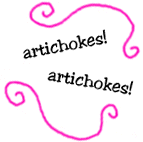 Here is a small selection of interesting inducers (and inhibitors) of romance, found in Harry Wedeck’s Dictionary of Aphrodisiacs ~ just doing my part to assist all of you lovers out there. We’ll begin with my favorite food . . .
Here is a small selection of interesting inducers (and inhibitors) of romance, found in Harry Wedeck’s Dictionary of Aphrodisiacs ~ just doing my part to assist all of you lovers out there. We’ll begin with my favorite food . . .
1961: Aphrodisiacs
![]() Artichoke
Artichoke
A bristly plant whose edible parts are the fleshy bases of the leaves. Considered a powerful aphrodisiac, especially in France. Street vendors in Paris had a special cry,
Artichokes! Artichokes!
Heats the body and the spirit.
Heats the genitals.
Catherine de Medici was fond of artichokes.
Consumption of artichokes may directly produce euphoria; indirectly, this sense of pleasant relaxation is highly conductive to amatory exercise.
Bananas
Considered to have stimulating aphrodisiac properties.
In all such cases, no single use of the food will be effective. What is true is that the continued consumption of, say, bananas, will be an aid in amatory directions.
Beverages
Ordinary coffee and tea, drunk to excess, may reputedly produce anaphrodisiac results.
Eels
Like most marine life, eels are said to possess aphrodisiac properties. In this regard eel soup is a highly favored dish.
Egg Drink
A highly potent drink consists of eggs, milk, salt, brandy, sugar or honey. Compounded into an egg flip.
Flowers
The aroma given off by flowers often has an aphrodisiac effect, especially on women. This is so particularly in the case of lilies of the valley, gardinia, frangipani, and henna.
Mathematics
It has been at least an academic tradition, if no more, that mathematical studies militate against amatory inclinations.
Sea-Slug
Found commonly off West Indies islands. Known widely for its efficacious aphrodisiac virtues. Among the fishermen of Naples, it is called sea Priapus.
Wedding Dinner
On account of their popular repute as an aphrodisiac, mushrooms were served, together with pepper and pine-nuts, at wedding dinners.![]()
Source: Wedeck, Harry E. Dictionary of Aphrodisiacs. New York: Philosophical Library, 1961.
~ pp. 36, 40, 45, 80, 81, 98, 149, 218, 248 ~